New

Turn Your DMs Into Lead Gen!
Learn how to collect lead data from your DMs such as email addresses, phone numbers, and more right from your social inbox. If you are not yet automating your DMs your competitors are outpacing you.

How Something Social Saved 75% of Their Time and Increased Revenue by 15%
See how a fast-growing agency improved operations, cut down hours of manual work, and unlocked new revenue opportunities with Vista Social.
New

50 Unique Social Media Ideas for Consistent Content Creation
Discover 50 unique social media post ideas to engage your audience, grow your brand, and maintain a consistent content strategy with ease!
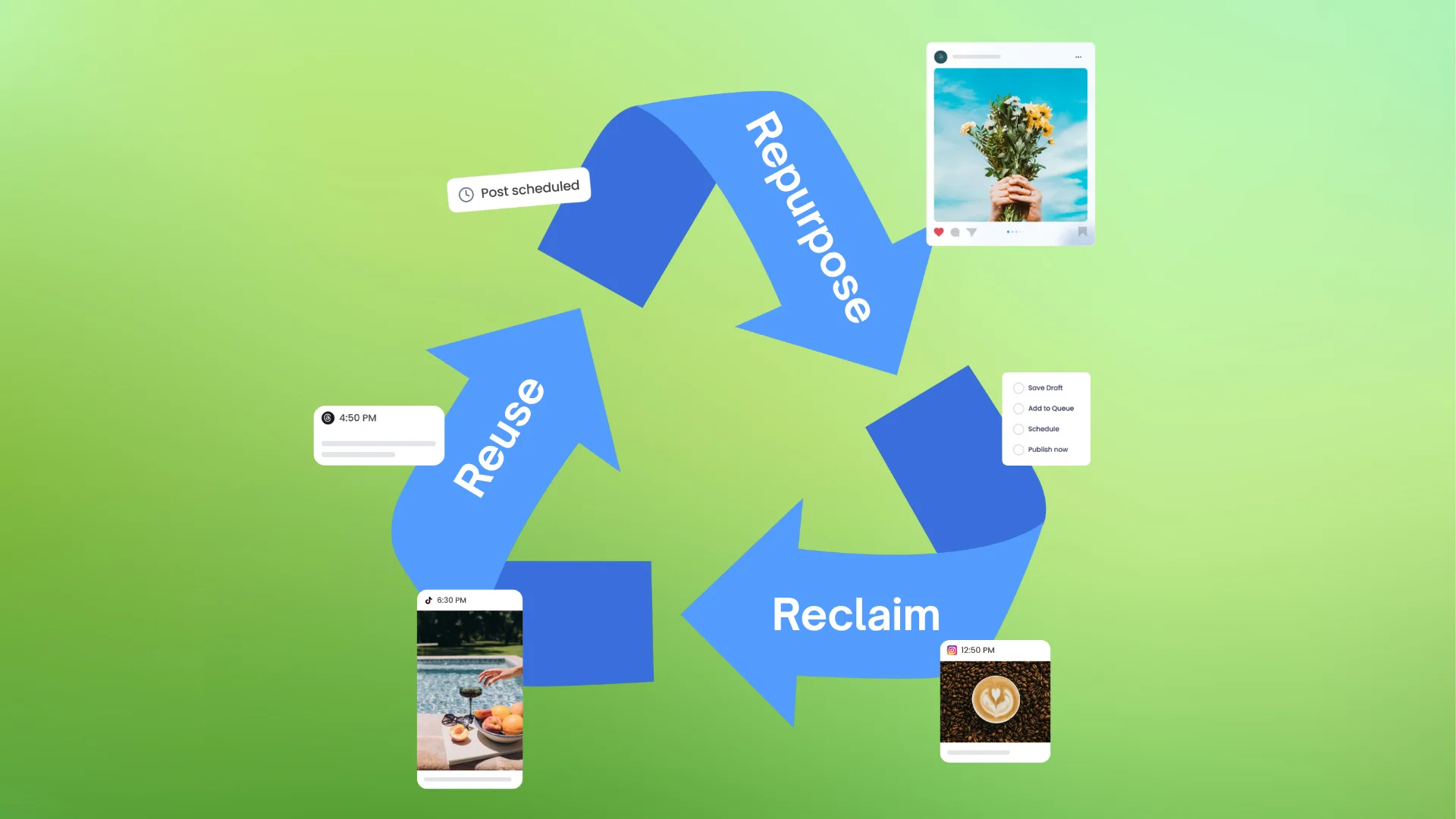
Mastering Content Reuse: The Key to a Consistent and Sustainable Posting Strategy
Published on March 27, 2025
16 min to read
What Is Social Commerce: w/ Tips, Tools, & Examples
Summarize with AI


Table of Content

Psst! Did you know you can turn your clients’ social media pages into profitable online shops?
It’s true, and it’s entirely possible with social commerce.
Weaving social commerce into your strategy helps clients provide seamless shopping experiences and memorable customer interactions while boosting their brand reach and revenue.
However, before implementing your strategies, you must understand social commerce, how it works, and how to leverage it to boost sales.
Let’s dive into this guide on social commerce—including tried and true tips, handy tools, and examples to help you hit the ground running.
Table of contents
What you will learn
- What is social commerce?
- Social commerce vs ecommerce: What is the difference?
- Why is social commerce important for brands?
- What are the best platforms for social commerce?
- What are the top social commerce tools?
- 12 Tried and tested tips for effective social commerce
- Social commerce examples
- FAQs on social commerce
- Jumpstart your social commerce efforts without a hitch
What is social commerce?
Social commerce is when brands and companies sell goods and services directly on social media sites and platforms.
Must read: Top 20+ Social Media Sites to Promote Your Clients [2025]
Generally, customers complete the purchase journey without leaving the platform, from the product discovery stage to the purchasing stage right from their social media apps.
Many social media platforms offer dedicated social commerce tools that allow internet users to create digital storefronts on Instagram, Facebook, TikTok, and Pinterest.
Social commerce vs ecommerce: What is the difference?
Social commerce and ecommerce have the same goal: drive sales.
However, the two are not the same.
Ecommerce refers to traditional online shopping via apps and websites.
Shoppers visit dedicated ecommerce sites such as Amazon, Shopify stores, and other digital stores to browse and buy products.
On the other hand, social commerce, a subset of ecommerce, integrates shopping with social media platforms.
Think of it as blending social interactions with the buying experience.
Social media users and shoppers can discover, learn about, and purchase products directly through Instagram, Facebook, or TikTok without leaving the app.
Essentially, social commerce brings the store to where your clients’ audiences hang out, making it easier for them to shop while they scroll.
Ecommerce is about shoppers visiting specific online stores to make purchases.
Why is social commerce important for brands?
The benefits of social commerce include the following.
Increased reach
Imagine tapping into a vast pool of potential customers already active on social media.
Social commerce exposes your clients’ products to a larger audience without additional marketing efforts.
Integrating shopping directly into your clients’ Instagram, Facebook, and TikTok pages allows you to reach more people and grow brand visibility effortlessly.
Seamless shopping experience
Picture a customer discovering a product they love and being able to purchase it within the same app without needing to navigate away.
Social commerce offers a frictionless buying process, making shopping easier and more enjoyable for your clients’ customers.
The convenience can lead to higher conversion rates and more satisfied social buyers.
Higher engagement
Social commerce encourages meaningful interactions with your clients’ audiences.
Engaging with customers through comments, messages, and live streams helps your clients build authentic relationships that foster brand loyalty and trust.
The higher level of engagement can translate into repeat business and strong brand advocacy.
Must read: Social Media Engagement Strategies, Tips, Examples and Tools
Access to User Generated Content
When customers share their purchases and experiences on social media, it creates a ripple effect.
The buzz generates valuable content that showcases your clients’ products in real-life settings, drawing more eyeballs and driving sales.
That said, User-Generated Content (UGC) acts as social proof, influencing potential social commerce buyers and boosting your clients’ brand credibility.
Gather real time feedback
Social commerce opens more opportunities to communicate with customers instantly.
Your clients can enhance customer satisfaction and demonstrate their commitment to buyer needs by addressing queries, concerns, and feedback in real time.
The ongoing dialogue can help clients refine their products and services based on valuable customer insights.
What are the best platforms for social commerce?
Many social media platforms offer social selling features to streamline and supercharge your efforts, including the following.
Instagram is a popular social selling platform for brands with visually appealing products and companies that want to engage with a highly visual audience.
Must read: How to Create an Instagram Content Strategy: Easy Steps
The platform’s social commerce features include the following.
- Shoppable posts that let you tag products in posts, allowing users to shop directly from your clients’ Instagram feeds
- Instagram Shops, where you can create a dedicated shop section on your clients’ profiles for seamless customer browsing and purchasing
- Product stickers that you can use in your clients’ Instagram Stories to tag products and make them shoppable with one tap
- An Instagram Live Shopping feature that allows you to host live shopping events where viewers can purchase products in real time
If your clients want to reach a wide audience and create a seamless social shopping experience within the platform, Facebook can be the right channel for their social commerce efforts.
Must read: Updated Facebook Video Size Guide for Marketers & Agencies
Facebook has the following social commerce features.
- Facebook Shops where you can create fully customizable online stores that live on your clients’ Facebook Pages
- Marketplace that lets you list products for sale in your clients’ local communities
- Facebook Groups where you can engage with niche communities and build relationships
- Messenger that provides a channel to communicate with potential customers and provide personalized services directly
- Live Shopping that allows you to host live video sessions to showcase products and interact with viewers in real time
TikTok
Clients targeting younger generations and the Gen Z demographic and leveraging viral content to drive online sales are best suited for social commerce on TikTok.
Must read: 31+ TikTok Content Ideas to Get More Followers this 2025
You can use the following TikTok features for effective social commerce.
- TikTok Shop that allows you to sell products directly through the app with shoppable videos
- Live Streaming features that help you engage with followers in real time and promote products during live sessions
- Branded Hashtags that you can leverage when creating or running challenges and campaigns to boost brand visibility
- In-feed ads that you can place within users’ feeds to reach a broader audience
- Creator Collaborations that let you work with influencers to tap into their established following, build trust, and expand your clients’ reach
Pinterest can be the right fit if your clients’ brands have visually appealing products and want to inspire and engage users through discovery.
Must read: How to Use Pinterest Analytics to Drive Traffic and Sales
Leverage Pinterest’s social commerce features, such as the following.
- Product Pins that you can create and link directly to your clients’ product pages for easy shopping
- Product Catalogs that you can upload to Pinterest for seamless integration with your clients’ online stores
- Shopping Ads that help promote your clients’ products to potential buyers
- Pinterest API for Shopping that lets you connect your clients’ ecommerce platforms for automated product pin creation
- Visual Search that allows users to search for products using images, making discovery faster and easier
Snapchat
If your clients’ social commerce strategies focus on engaging with a younger audience through interactive and immersive content, then Snapchat can be the best social network for them.
Must read: 10 Snapchat Marketing Tips: How to Grow Your Following
Check out Snapchat’s social commerce features below.
- Shoppable AR Lenses that let you use augmented reality to allow users “try on” your clients’ products virtually
- Snapchat Ads that appear between stories or in the Discover section to help get them in front of target audiences and potential customers
- Snap Map that showcases your clients’ business locations to help attract local customers
- The Discover feature that showcases your clients’ brands in the Discover section, helping them reach wider audiences
- Influencer Partnerships that let you collaborate with popular Snapchat creators to promote your clients’ products
YouTube
YouTube is best for brands that leverage influencer marketing and product demonstrations to drive sales.
Jumpstart your clients’ social commerce initiatives on YouTube with the following features.
- Shoppable Videos where you can add product links directly within your clients’ content to make the buying experience as seamless as possible
- YouTube Live streams where you can showcase your clients’ products and interact with viewers, boosting engagement
- Affiliate marketing features that allow you to collaborate with creators to promote products and earn commissions
- YouTube Shorts where you can create and publish short, engaging videos to highlight your clients’ products and drive sales
- A Community Tab that helps you engage with your clients’ audiences through posts, polls, and updates
What are the top social commerce tools?
The right tools are crucial to your social commerce efforts’ success, so choosing reliable ones is important, such as the following.
Vista Social
If you want an all-in-one tool that has everything, from social media publishing and engagement management to analytics and reporting, Vista Social can be just your solution.
The modern social media management platform offers robust features to supercharge your social commerce efforts while streamlining your workflows.
The platform’s social media publishing feature (Publisher) helps you create, customize, and schedule your clients’ social media posts for auto-posting.
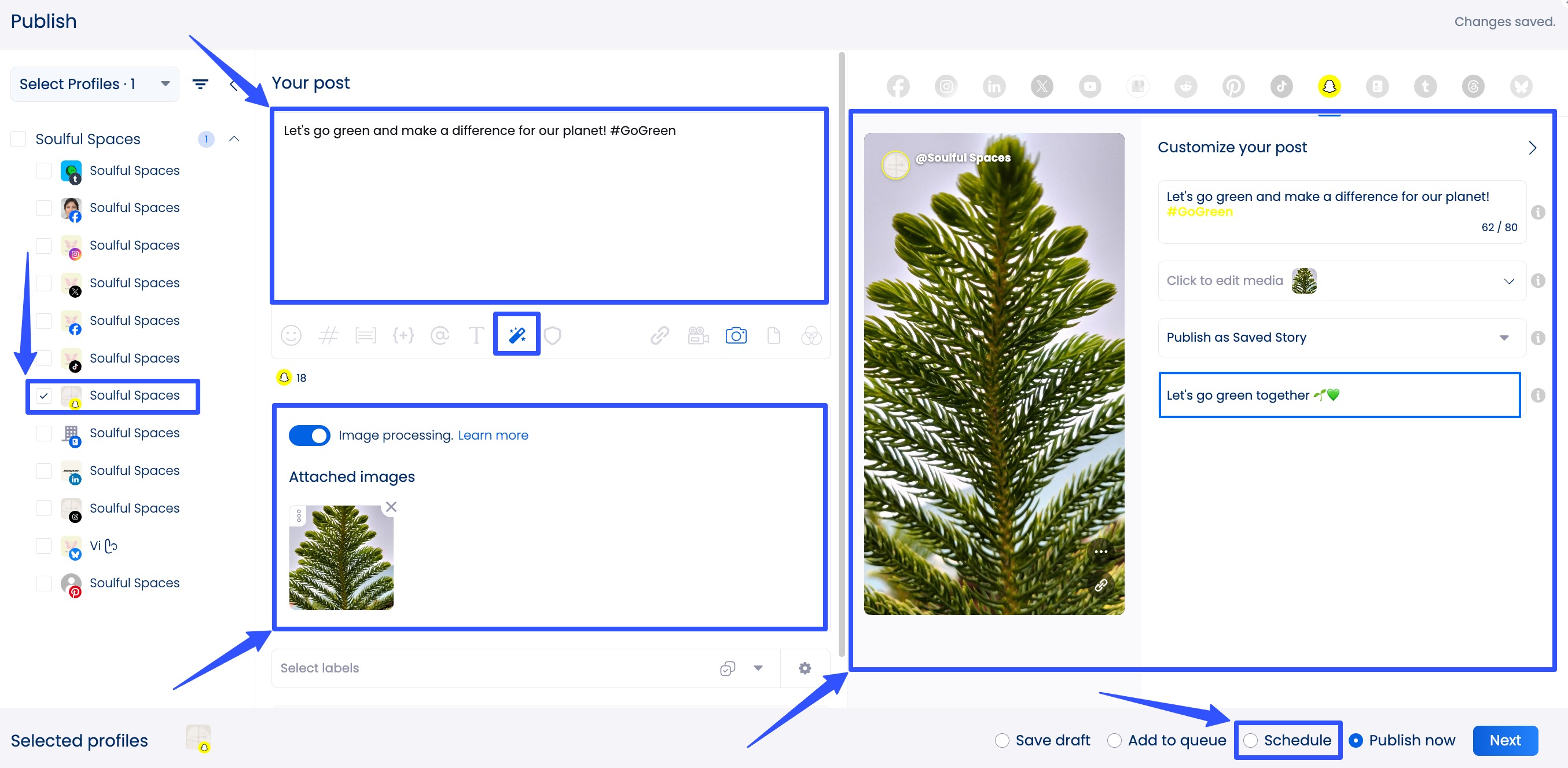
The Publisher includes an AI Assistant that instantly generates and refines your post descriptions and taglines.

The Publisher also includes a Canva integration so you can edit product photos and other social commerce visuals easily without leaving Vista Social.
Must read: Visual Content Creation Tips & Tools for Agencies this 2025

After creating your post, you set a posting date and time or choose from Vista Social’s optimal posting time suggestions.
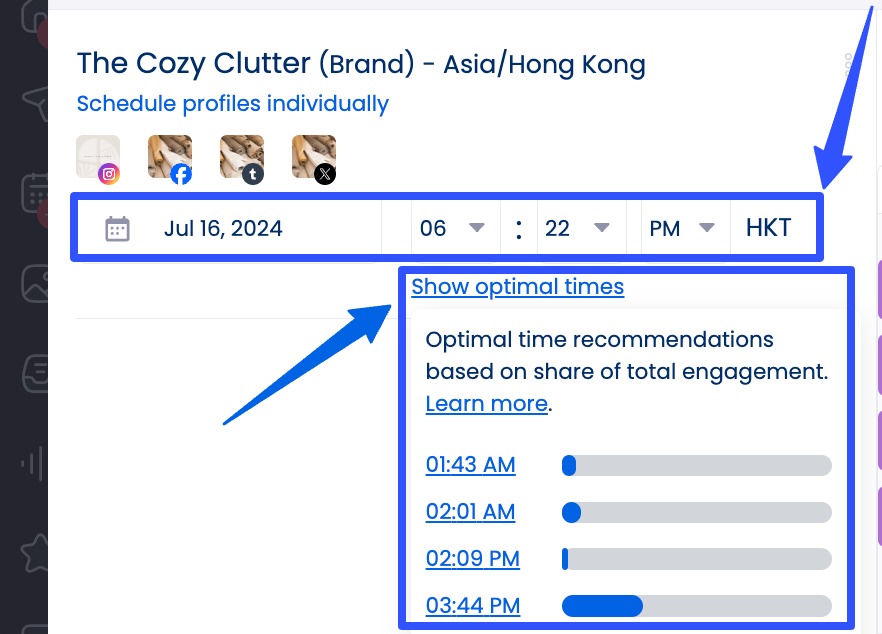
The feature looks at previous engagement data and uses optimization algorithms to predict the best time to post for maximum engagement.
You can manage all your scheduled, drafted, and previously published social media posts on the content calendar.
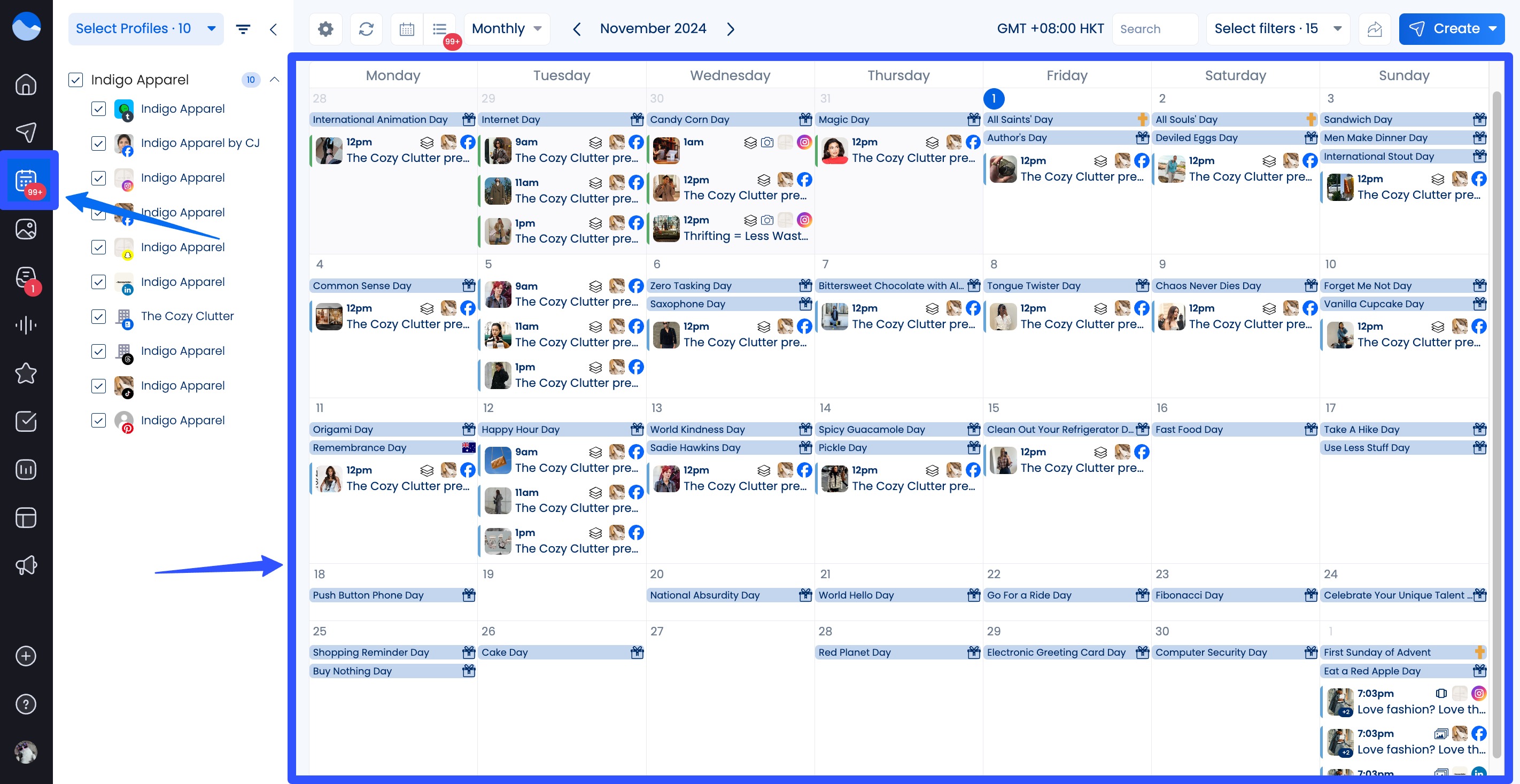
The content calendar, scheduling, and auto-posting features simplify planning and developing your clients’ social commerce content.
Must read: How to Automate Social Media Posts: w/ Tools & Tips
Effective social commerce involves more than promoting your clients’ products and services via photos, images, and other content types.
Your clients must also engage audiences effectively to connect with them better, build lasting relationships, and convert passive audiences into paying customers.
Vista Social’s social media engagement feature makes engaging with your clients’ audiences more efficient via the Social Inbox.
It centralizes all the comments, mentions, messages, and reviews from your clients’ connected social media profiles.
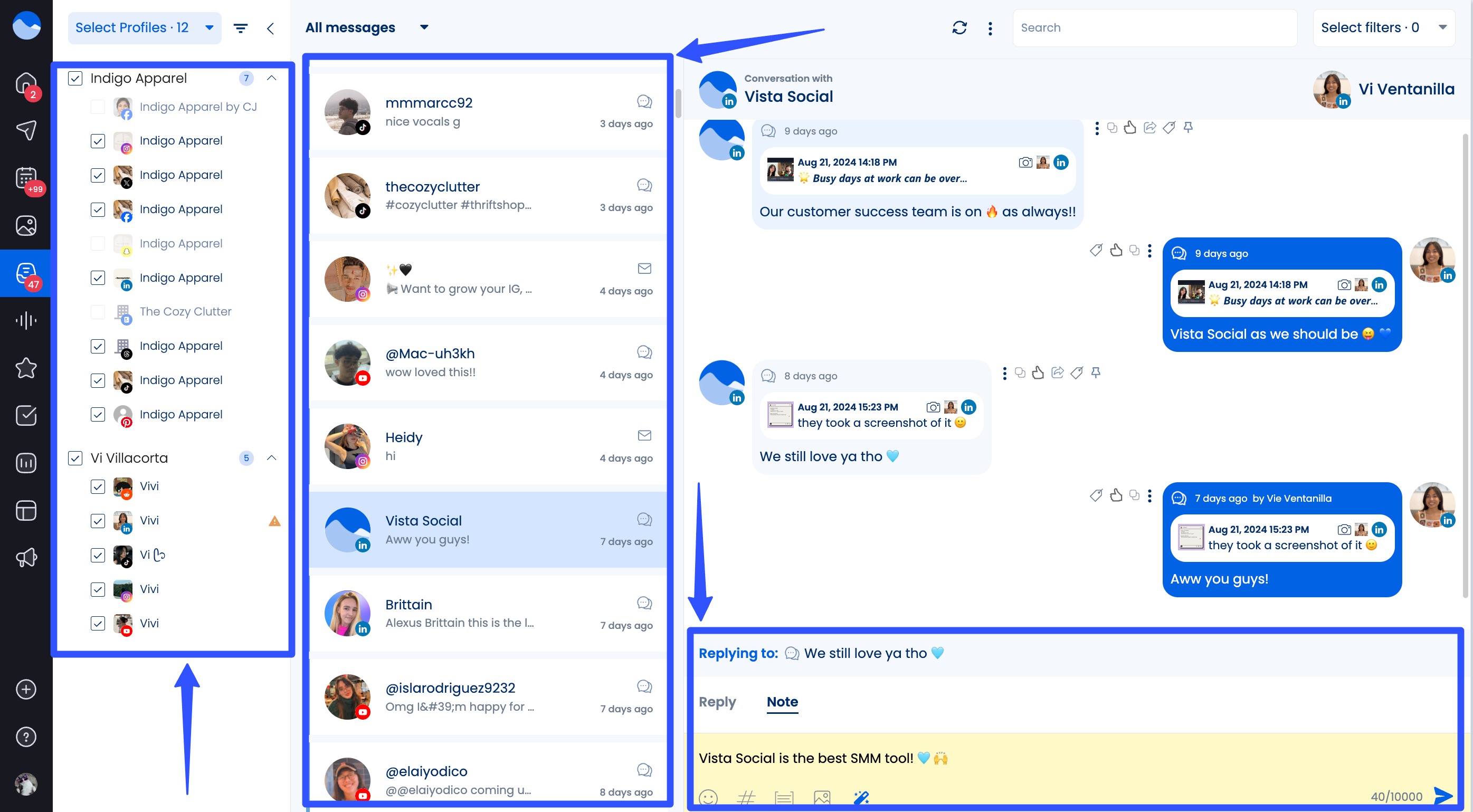
This way, you can easily view, interact with, and respond to (available for Facebook and Instagram) audience engagement without constantly switching among platforms, saving time and energy.
Use Vista Social’s social media listening tool to know what followers say about your clients’ brands.
It lets you set up Listeners that can pull social media conversations that mention your clients’ brand names, products, or other relevant keywords to get a pulse on their brand health.
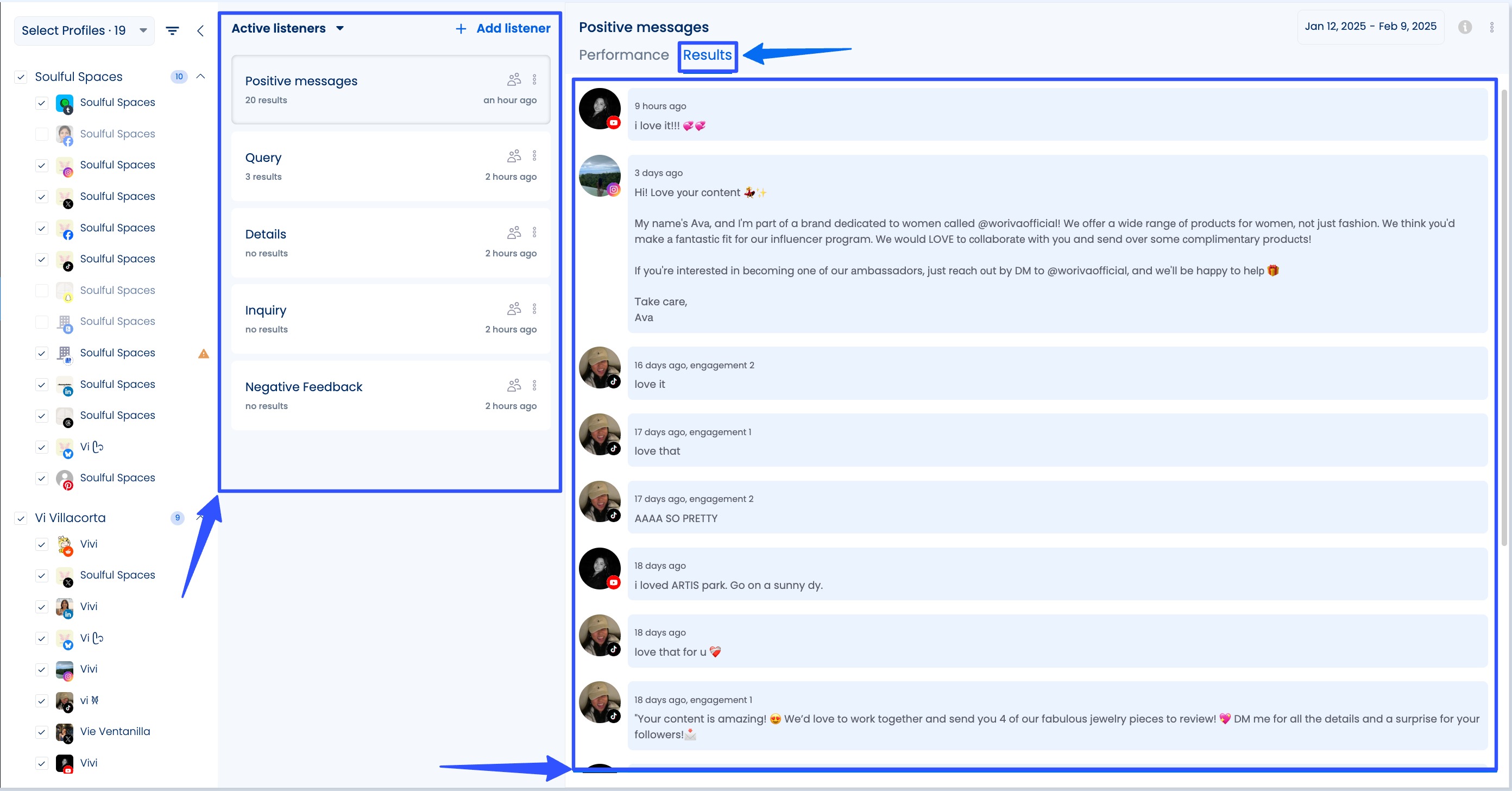
The feature includes automatic sentiment tagging and analysis reporting to help you assess whether customers have positive, neutral, or negative experiences with your clients’ brands.
Must read: 20+ Sentiment Analysis Tools for Agencies & Brands for 2025
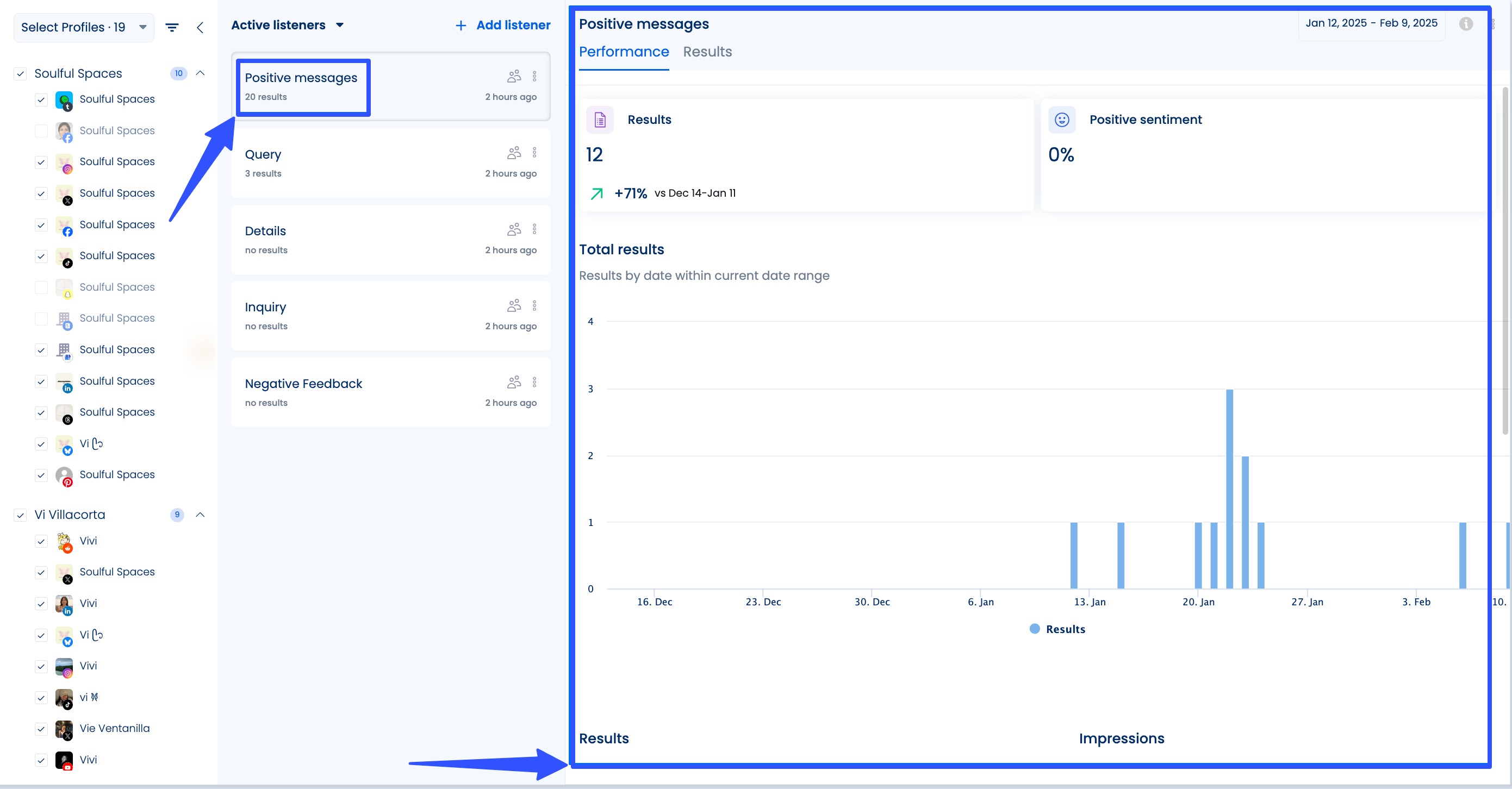
Tracking and analyzing key metrics is a breeze with the platform’s social media analytics feature.
It allows you to schedule reports that give you critical content performance and audience engagement insights.
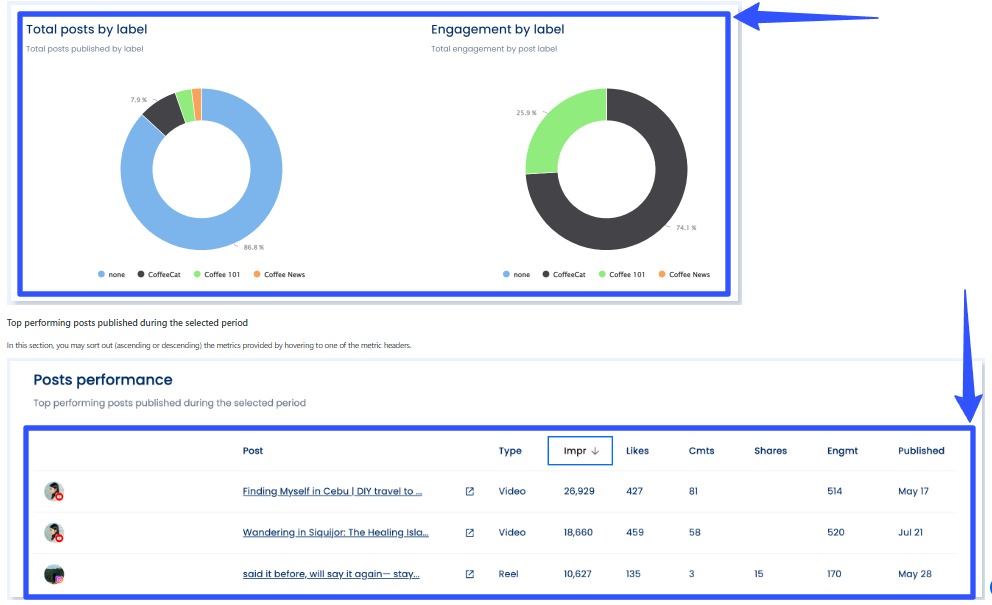
The feature includes options to create custom report templates and share your reports via interactive links or exported CSV or PDF files.
The reports can help determine whether your clients’ social commerce content and audience engagement campaigns work or need adjusting.
Another handy feature is Vista Page, the Vista Social’s link in bio tool that includes customizable landing pages to amplify your clients’ social commerce efforts.
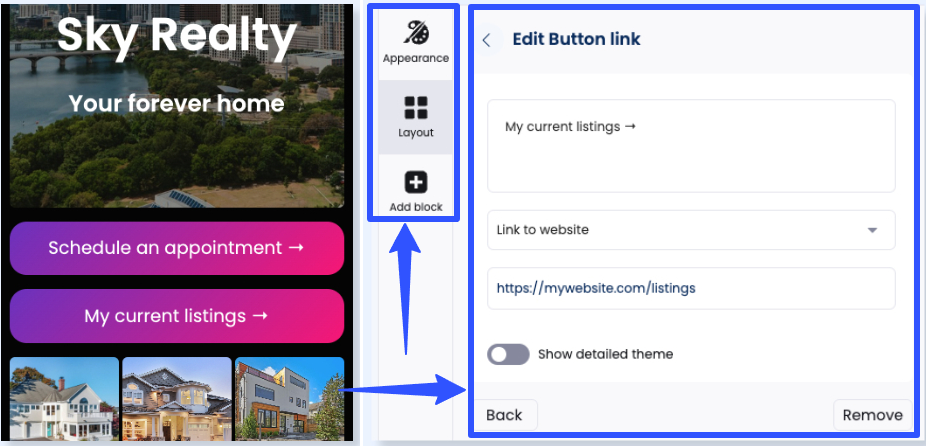
The tool allows you to create mini-websites or storefronts with conversion content and tools to help your clients’ drive traffic and sales.
You can even use Vista Social’s Publisher to create and schedule content to auto-publish on your clients’ link in bio pages.
Try Vista Social for Free
A social media management platform that actually helps you grow with easy-to-use content planning, scheduling, engagement and analytics tools.
Get Started NowOther Vista Social features you can leverage for social commerce include the following.
- Review management
- Post approval workflows to streamline your content review and approvals
- Hashtag tools
- Employee advocacy
- Bulk publishing
- Content finder to search UGCs easily and supplement your clients’ social commerce-related posts
- Integrations with other business tools, such as Slack and Zapier
- Instagram product tagging in images to make them shoppable

Adobe Express
Adobe Express (formerly Adobe Spark) is an all-in-one platform for creating stunning graphics, web pages, and short videos.
It offers an intuitive interface and various customizable templates, making it easy to design visually appealing content for your social commerce initiatives, social media marketing campaigns, and other creative projects.
You can leverage the following Adobe Express features for social commerce.
- Professionally-designed, customizable templates you can use to create eye-catching social media posts, stories, and ads
- Branding tools to easily add logos, colors, and fonts to maintain brand consistency across all your clients’ social media content
- Collaboration tools that allow you to invite team members and clients to collaborate on projects for seamless workflow and feedback integration
- AI-powered features such as Adobe Sensei’s AI capabilities that can optimize your content layout, auto-crop images, and enhance visuals for multiple platforms
- Tools for creating animated videos, GIFs, and interactive web pages that capture audience attention and drive engagement
- Cross-platform syncing options to access and edit your projects on web and mobile devices, ensuring flexibility and convenience
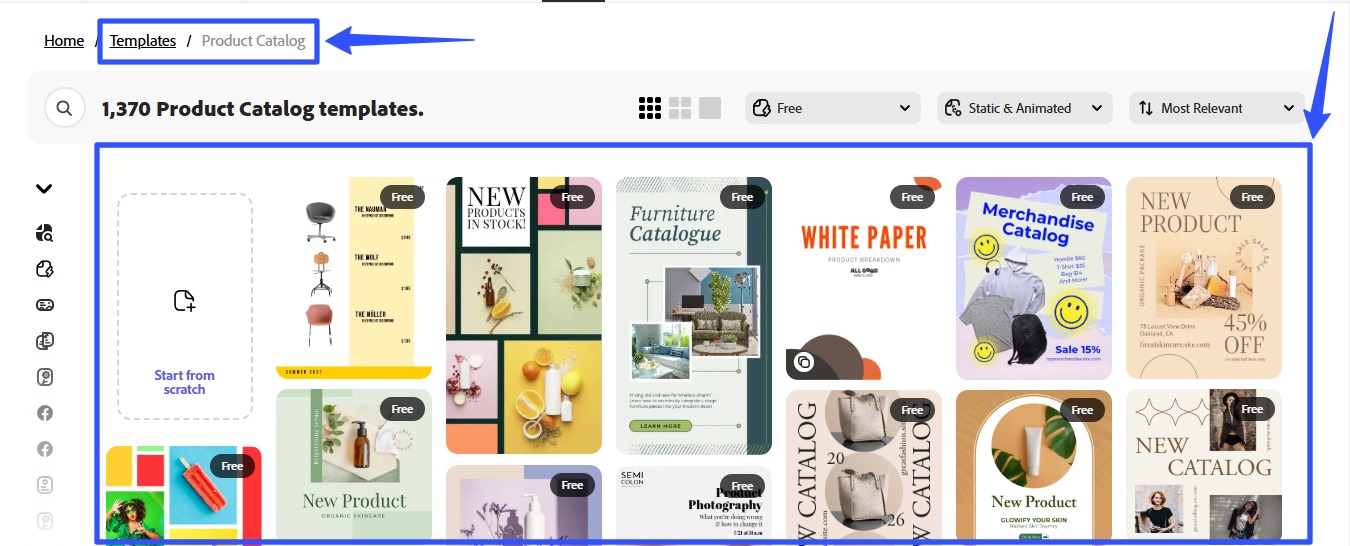
Shopify
Shopify is a popular ecommerce platform that lets you create and manage online stores.
It offers several social selling features that allow your clients’ ecommerce businesses to reach and engage with customers on various social media platforms.
The platform’s social channel integrations can streamline your social commerce campaigns and drive sales directly from their social media presence.
Shopify’s core social commerce features include the following.
- Multi-channel selling. Integrate your clients’ Shopify stores with social media platforms like Facebook, Instagram, TikTok, and Pinterest to sell products directly on these channels
- Shoppable posts. Create shoppable posts and Stories on Instagram and Facebook, allowing customers to purchase products without leaving the app
- Social media ads. Run targeted ad campaigns on social media platforms to help your clients reach potential customers and drive traffic to their Shopify stores
- Inventory management. Sync your clients’ inventories across all their social commerce sales channels, ensuring that their stock levels are always up-to-date
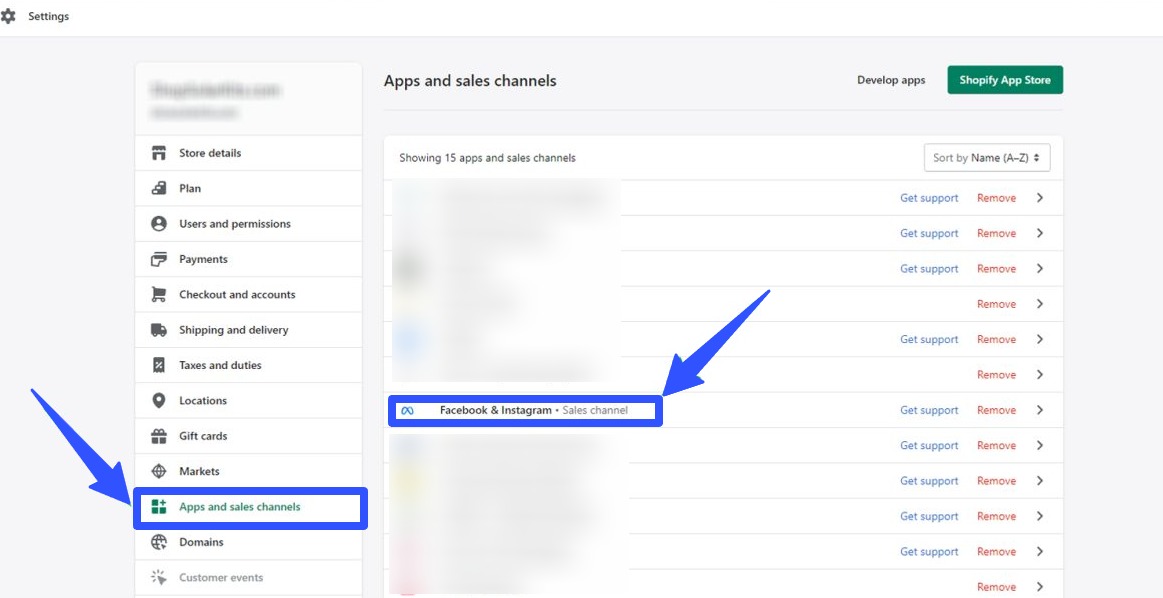
12 Tried and tested tips for effective social commerce
Consider the best practices below to help position your social commerce efforts for success.
1. Choose the right social commerce platform
Each social platform caters to various audience groups and customers.
Ensure you understand where your clients’ target customers spend their time online.
For example, Instagram and TikTok are great for visual products, while LinkedIn may work better for B2B services.
Running your clients’ social commerce campaigns on the best-fitting platforms or tweaking your efforts according to each social channel increases your chances of succeeding.
2. Optimize your social media profile
First impressions count!
Remember that a professional profile sets the tone for your brand, so follow the quick tips below.
- Use a high-quality profile picture, preferably your client’s logo
- Create a compelling bio that tells audiences what your clients’ do and the unique value they offer
- Include links to your clients’ online stores, websites, or other relevant platforms.
- Keep your clients’ handles, profile pictures, and bio content consistent across all their active social media platforms
3. Create quality content
To drive social commerce sales effectively, focus on creating high-quality, visually appealing content that resonates with your clients’ audience.
Must read: 20 Top Social Media Strategies for SaaS Companies this 2025
Some effective strategies to ensure top-quality content include the following.
- Invest in high-resolution images and videos to offer professional-looking visuals that grab the attention of your clients’ potential customers. High-quality visuals also foster credibility and trust in your clients’ brands
- Use a mix of content types such as photos, behind-the-scenes videos, user testimonials, and educational posts. The variety helps keep your clients’ social media content fresh and engaging, drawing in potential customers
- Encourage UGC by asking your clients’ followers to share their experiences with their products and services. Sharing glowing reviews helps put your clients’ brands in a good light, encouraging more customers to check out what your clients offer
4. Leverage influencers
Influencer marketing can take your social commerce initiatives to new heights with the right strategy.
Collaborate with influencers who align with your clients’ brands to reach a broader and more engaged audience.
Start by:
- Identifying influencers who align with your clients’ brand values, industries, and target audiences
- Collaborating on content that feels authentic and beneficial to both parties
- Tracking the performance of influencer collaborations to understand their impact on your clients’ sales and brand awareness
5. Use social media features
Use the built-in features of social media platforms, such as Instagram Shopping, Facebook Marketplace, and Pinterest Buyable Pins.
These features make it easier for customers to shop directly from your clients’ posts, amplifying their social selling strategies.
6. Run contests and giveaways
Contests, giveaways, and other gamification tactics can increase your clients’ engagement and attract new followers.
Must read: Social Media Gamification Tips to Skyrocket Engagement
Follow the tips below on hosting contests and giveaways to support your social commerce efforts.
- Make the entry requirements simple, such as liking the post, following your client’s Instagram or TikTok account, and tagging friends
- Promote your clients’ contests on multiple platforms to reach a wider audience
- Offer desirable prizes that resonate with your clients’ target audiences, such as new brands or products and exclusive discounts
7. Offer exclusive deals
Everyone loves a good deal, so use exclusive offers to draw more eyeballs and potential customers to your clients’ products and social media shops.
You can:
- Offer exclusive discounts or promotions to your clients’ social media followers to encourage purchases and build a sense of community
- Share discount codes, special offers, or early access to new products with your clients’ social media followers
- Promote these deals through posts, stories, and direct messages
- Create a sense of urgency with limited-time offers
8. Ensure consistent branding
Maintain a consistent brand voice and visual style across all your clients’ social media channels.
Consistency helps build brand recognition and trust, which is essential for the effectiveness of your social commerce strategies.
Follow these quick tips for branding consistency.
- Use the same color palette, fonts, and logo across all your clients’ social media channels
- Maintain a consistent tone of voice that aligns with your clients’ brand personalities
- Regularly update your clients’ profile pictures, banners, and posts to reflect their branding
9. Work with other brands
Like influencer marketing, collaborating with other brands can help your clients reach a new audience, expanding their reach and sales opportunities.
Ensure effective brand collaboration with the following tips.
- Look for brands that complement your products and share a similar target audience
- Co-create content or run joint campaigns that benefit both brands
- Share each other’s posts to cross-promote your clients and the other brands’ products and services
10. Incorporate storytelling
Use storytelling to create connections with your clients’ social media audience.
Sharing the story behind your brand, products, and customers can show your clients’ authenticity and resonate with potential customers.
Follow the quick tips below when weaving storytelling into your social selling strategy.
- Share the story of how your clients’ brands started, their mission, and values
- Highlight customer stories and testimonials to show the real-life impact of your clients’ products and services
- Use narratives in your clients’ social media posts and videos to make their content more engaging. The more engaging their content, the higher the chances of audiences converting into paying customers and retaining them as loyal buyers
Must read: 10 Social Media Customer Retention Tools for Agencies
11. Test and learn
Experiment with new strategies and learn from your results.
Social commerce is constantly evolving, and staying adaptable is key to your and your clients’ success.
Find what works best by:
- Trying various types of content, posting times, and engagement strategies and analyzing audience responses and the impact on your clients’ sales
- Monitor the results and make adjustments based on what you learn
- Stay up-to-date with social commerce trends and incorporate new features and tools
12. Provide excellent customer service
Ensure that your clients offer top-notch customer support.
Quick responses and problem resolution can turn a potentially negative experience into a positive one.
Remember, with great customer service comes great customer experience, so consider the following tips.
- Be responsive and helpful in addressing customer inquiries and issues
- Use social media chatbots to provide quick answers to common questions
- Follow up with customers to ensure their satisfaction and encourage repeat business
Social commerce examples
Get inspiration from the social commerce examples below.
Vista Social
Your clients’ social media pages can be excellent channels to showcase how new and key features can benefit audiences and potential buyers.
That’s exactly what Vista Social does: share Instagram posts highlighting their core social media management tools and how they can help customers solve their problems.
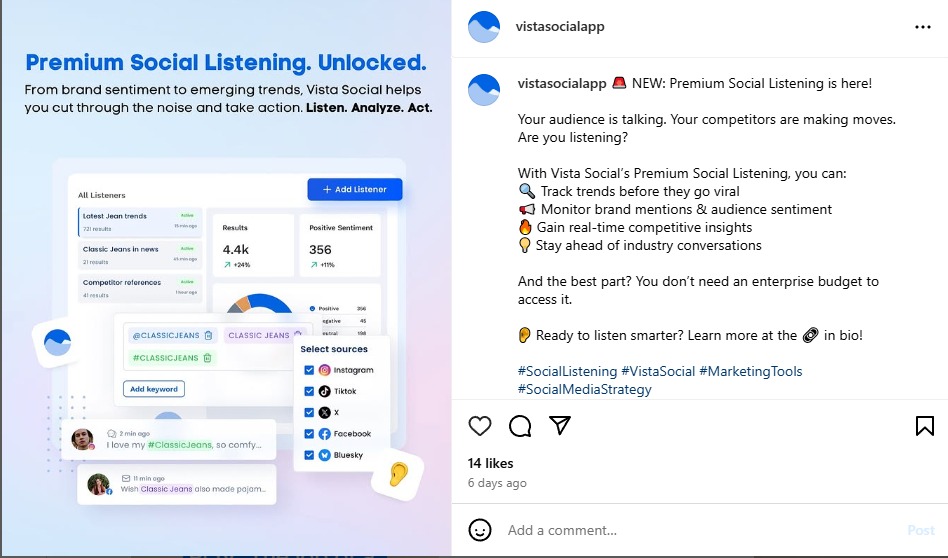
It’s a great way to announce and share new features or products with audiences who are likely already tuned in to your clients’ brands.
Poo-pourri
Natural odor freshener company Poo-pourri keeps its TikTok content relatable and fun, engaging followers and potential customers in their videos.
For instance, the video below shows a woman receiving Poo-pourri items as gifts with the caption, “My family knows me too well.” This creates a sense of desire for the product.

The person in the video likes the product, which can make other people curious and want the product, too.
It’s one way of subtly enticing audiences to buy your clients’ products, which often works.
ILIA Beauty
Cosmetics and skincare brand ILIA Beauty takes customer service seriously. It used its Facebook Messenger chat to assist customers and answer common queries quickly.

You can also set up your Messenger chatbot to provide product recommendations for a more personalized online shopping experience.
Providing this kind of customer service helps your clients give prompt responses via social media channels that many customers prefer.
It can give seamless experiences, encouraging repeat business and even positive customer reviews from satisfied buyers.
FAQs on social commerce
Do you need a large following to succeed in social commerce?
While having a large following can help, it’s not a necessity.
Success in social commerce can depend more on your clients’ engagement, quality content, and effective use of social media features.
Even with a smaller following, you can achieve great results by targeting the right audience and providing value to customers.
How can you improve your social commerce strategy?
Some of the effective ways to improve your social commerce strategy are to create high-quality content, engage with your audience, leverage influencers, and use social media features such as shopping tags and buyable pins.
A data-based approach is to track your clients’ analytics to understand what works and refine your social commerce strategy accordingly.
Is social commerce safe for your customers?
Yes, social commerce is generally safe for customers.
Social media platforms implement various security measures to protect users’ private and financial information.
Must read: Social Media Privacy Laws Evolution: What Brands Need to Know
However, it’s crucial for your clients’ businesses to follow best practices and ensure their online stores are secure to cover all their bases and keep everything secure.
What are the challenges of social commerce?
Some of the common social commerce challenges include the following:
- Keeping up with constantly changing social media algorithms and platform features
- Managing customer expectations and providing excellent customer service across multiple social media platforms
- Ensuring data privacy and security for customers
- Staying ahead of competitors in a crowded market
- Keeping audiences engaged and coming back for more
- Measuring the exact ROI based on retail social commerce sales
Jumpstart your social commerce efforts without a hitch
Achieving success in the world of social commerce won’t happen overnight.
However, you can point your efforts toward success by following time-tested tips, using the right social commerce solution, and learning from other brands.
Choose the best tools for social commerce, such as Vista Social.
The platform has everything you need to launch and implement winning social commerce campaigns and strategies for your clients.
About the Author
Content Writer
Jimmy Rodela is a social media and content marketing consultant with over 9 years of experience, with work appearing on sites such as Business.com, Yahoo, SEMRush, and SearchEnginePeople. He specializes in social media, content marketing, SaaS, small business strategy, marketing automation, and content development.
Read with AI
Save time reading this article using your favorite AI tool
Summarize with AI
Never Miss a Trend
Our newsletter is packed with the hottest posts and latest news in social media.

You have many things to do.
Let us help you with social media.
Use our free plan to build momentum for your social media presence.
Or skip ahead and try our paid plan to scale your social media efforts.
P.S. It will be a piece of cake 🍰 with Vista Social
Subscribe to our Newsletter!
To stay updated on the latest and greatest Social Media news. We promise not to spam you!


